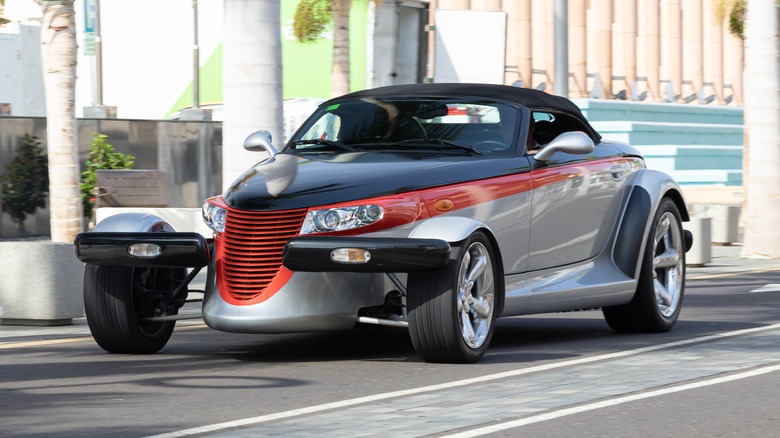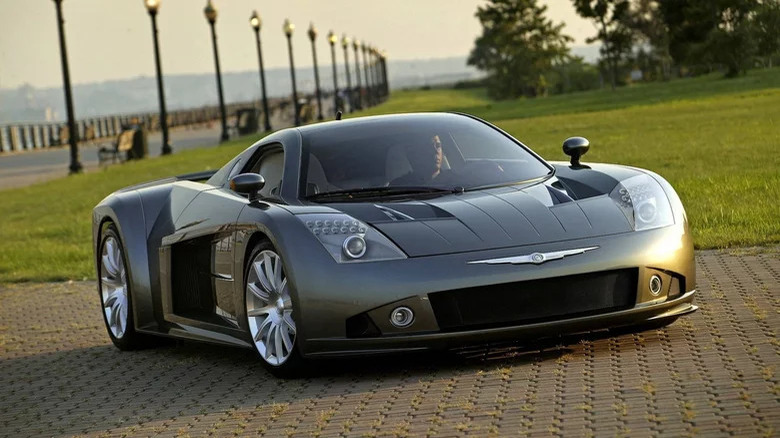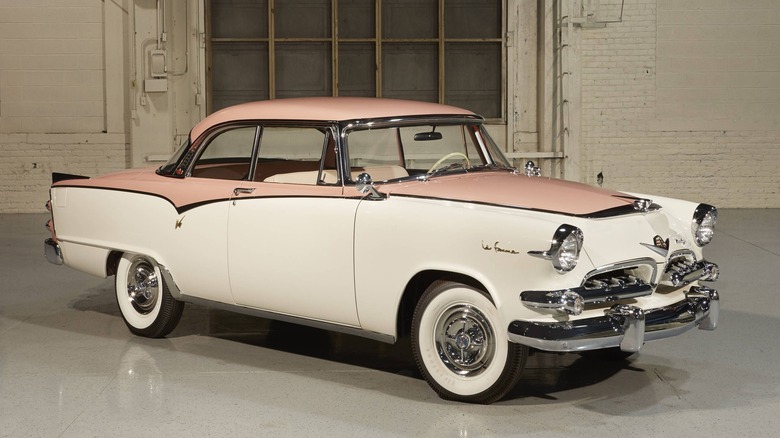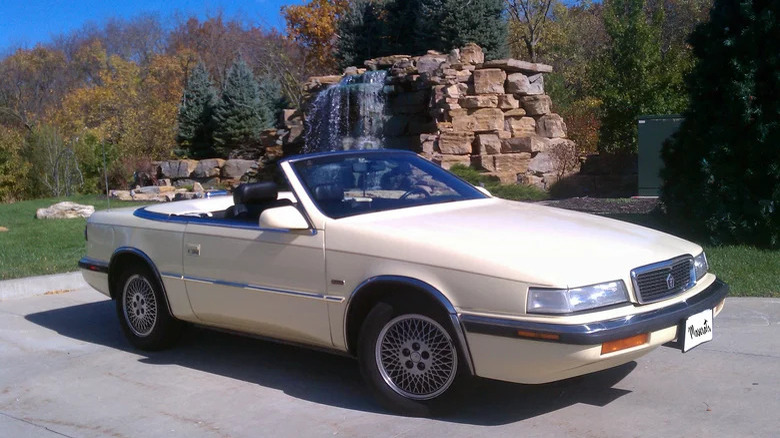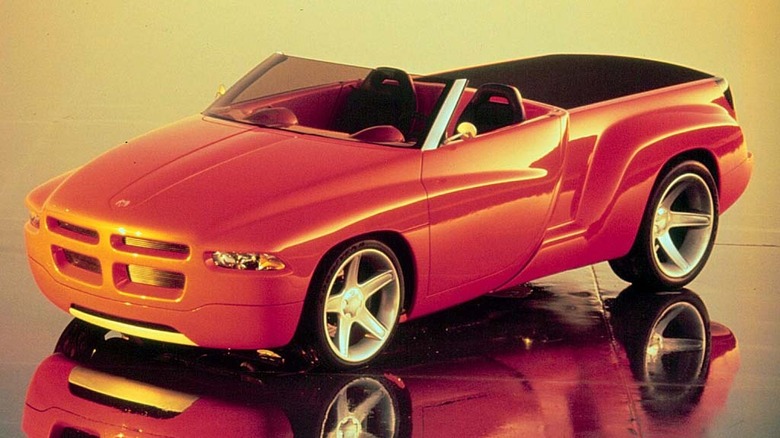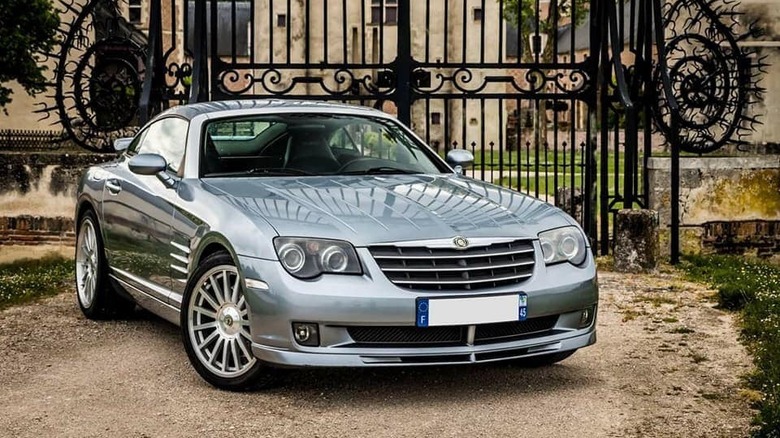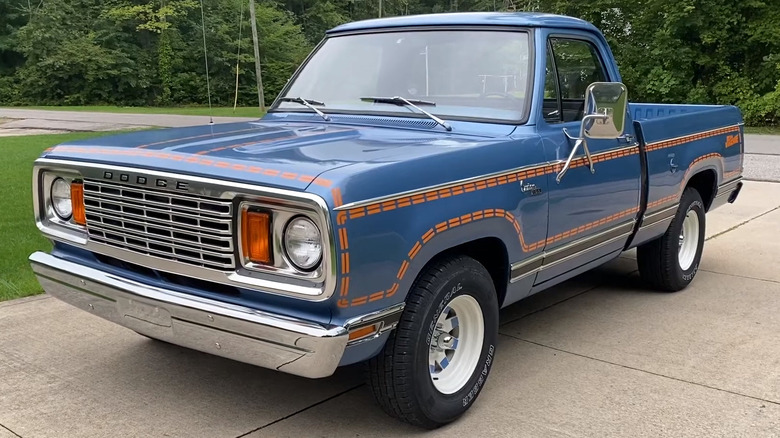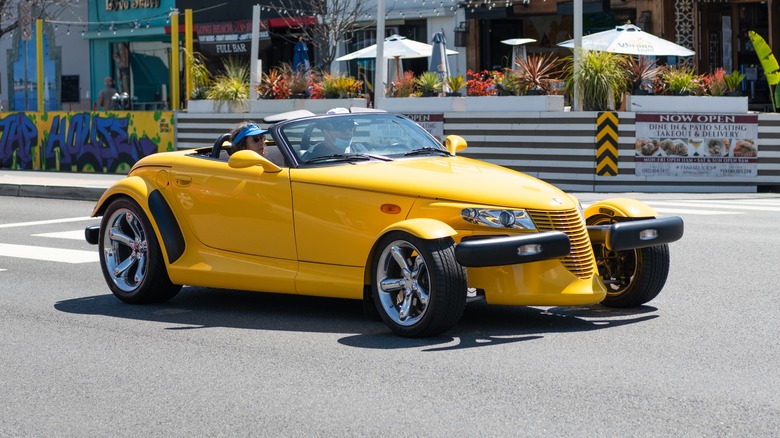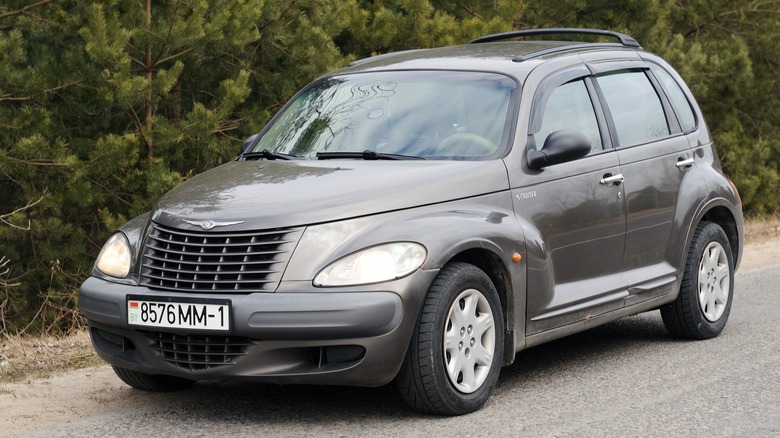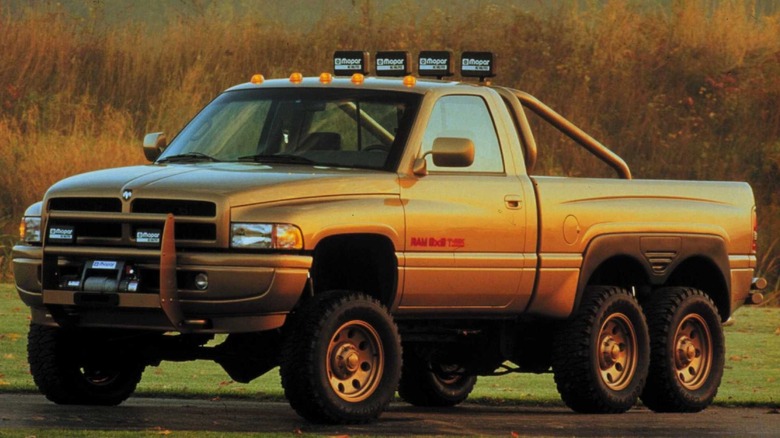10 Of The Strangest Cars Ever Built By Chrysler
Since its inception in 1925, Chrysler has remained one of the American automotive industry's biggest players, with countless well-loved models in its back catalog, both under its own name and through its many subsidiaries. Since 2021, it's been a division of the Stellantis conglomerate, and like most major carmakers, it's now preparing to switch to electric power. The brand's first battery-powered electric vehicle (EV) is expected to launch in 2025, with big changes promising to take the brand in a new, unexpected direction.
However, the new EV will be far from the first time the brand has launched an unexpected car. Over the decades, there have been plenty of strange vehicles, both concepts and production cars, that the automaker has unveiled. As Chrysler prepares to relaunch itself and deliver its first new vehicle since its latest takeover, it's a great time to look back through the archives and revisit ten of its strangest creations.
Chrysler ME Four-Twelve
One of Chrysler's strangest cars is also one of its most impressive, and it shocked brand enthusiasts when it was first unveiled in 2004. The ME Four-Twelve is a mid-engine, V12-powered supercar that was a world away from anything the marque had produced before, so much so that it was initially written off as a marketing stunt by some. However, those claims were put to rest when MotorTrend took the prototype for a test drive and confirmed it felt faster than the Ferrari Enzo, which at the time was the industry benchmark and one of the fastest cars on the planet.
Chrysler claimed the car could produce 850 horsepower using quad turbos, which would have been a groundbreaking figure for a production car. And Chrysler was intent on putting it into production, too; company bosses confirmed as much and targeted a start price of somewhere between $250-750,000. However, the project was eventually canned for unknown reasons.
There are several theories as to what went wrong: the most likely one is that the company simply couldn't make the financials work or find enough willing buyers. However, it's also been speculated that Daimler bosses halted the project since the car's V12 engine was sourced from AMG, and Mercedes had just launched its SLR McLaren supercar at the time of the ME Four-Twelve's debut. The Chrysler would have been much faster, potentially embarrassing the German manufacturer, so it never got made.
Dodge La Femme
Advertising cars with women in mind was a very effective sales tactic during the early '50s. Many said adverts focused on how easy the car was to drive or how stylish it was. However, carmakers generally stopped short of promoting cars as being specifically for women – that is until Dodge came along in 1955 with one of the most ham-fisted attempts at gender-specific marketing in automotive history. The Dodge La Femme seemed to be developed by men without any input from women, based purely on the broadest stereotypes about the female gender.
For starters, it was only available in a two-tone white and pink color scheme with a matching interior. It came with plenty of extras, too: Dodge threw in things like a handbag, an umbrella, and a coat, all color matched to the car. Needless to say, the car was a commercial failure, only on sale for two years before being unceremoniously axed. It's thought that around 2,500 examples were sold over its production run, and only a small handful of those survive today.
Chrysler TC by Maserati
One of carmaking's strangest-ever collaborations has to be the Chrysler TC by Maserati, which was, in essence, a dressed-up Chrysler LeBaron. It's thought that the deal was made possible thanks to the friendship between the two company bosses, with both parties getting a good deal in theory -– Chrysler would be getting a cool new car with exotic Italian appeal, and Maserati would be getting a much-needed cash injection. It was decided that Chrysler would provide all the oily bits while Maserati handled the styling.
The trouble was that styling looked a little too similar to the regular LeBaron, and underneath, it still was pretty much a regular LeBaron — just a very expensive one. The car drew the most criticism for that high asking price, roughly double that of the LeBaron, which many thought wasn't justifiable given its humble roots and largely unremarkable improvements over its stablemate. In true Italian fashion, it also developed a reputation for being more unreliable than the lesser Chrysler. Nonetheless, around 7,000 TCs were sold before the decision to retire the car.
[Featured image by Mesatrooper via Wikimedia Commons | Cropped and scaled | CC BY-SA 3.0]
Dodge Sidewinder
The idea of combining a car's comfort with a truck's practicality was nothing new by the time the Dodge Sidewinder concept was unveiled. However, making a truck with a car's performance, specifically a V10-powered supercar, was still a wild idea. Nonetheless, that's exactly what Dodge set out to do in 1997, and the resulting creation was unsurprisingly bizarre. The Sidewinder's engine was borrowed from the Viper GTS-R race car and produced 640 horsepower. All those horses were sent to the rear wheels by a four-speed manual transmission -– no slushboxes here.
The convertible roof might look out of place on a pickup today, but it wasn't unheard of at the time – only a few years before the Sidewinder's unveiling, Dodge had released the Dakota Convertible to capitalize on the trend. Although the Sidewinder itself never made production, the company continued toying with the idea of a production V10-powered pickup, and eventually, the Ram SRT-10 was unleashed in the mid-'00s.
Chrysler Norseman
The Norseman is one of Chrysler's biggest mysteries, as despite there being concrete proof of its existence, almost no one outside of select members of the brand's development team ever saw it. They never will, either: it sits, decaying, at the bottom of the Atlantic Ocean, with divers reporting that it's now almost unrecognizable save for its tires. The car was designed in collaboration with Ghia and was being shipped back from the Italian studio's facilities after initial testing, with a grand unveiling planned once it reached American shores. However, the ship it was being carried on, the "SS Andrea Doria," was involved in a major collision with another ship, with 51 people tragically losing their lives in the accident.
The Andrea Doria sank, carrying all of its cargo, including the Norseman, with it. In a turn of events that draws a parallel with the recent Titan submersible disaster, the shipwreck became a popular site for exploration dives but proved very dangerous, with over two dozen divers killed there to date. The Norseman was said to be packed with innovations, the most notable of which was the pillarless roof. It was claimed to hold several times the car's weight, making it safer than many other cars of the era, yet impressively futuristic looking. The car benefited from a reported 50,000 hours of research, some of which was lost forever when the Norseman sank. A cutting-edge Chrysler, no doubt, even if the public never laid eyes on it.
Chrysler Crossfire SRT-6
The Chrysler Crossfire SRT-6 is much less exotic than a sunken concept or V12-powered supercar, but it's no less strange. The regular Crossfire was hardly the runaway success that Chrysler had hoped for, but it had found a niche as a pseudo-sports car that delivered decent handling and styling that was, at the time, generally well-liked. It was a car for people who wanted something less scary than a sports car but still had the look. The trouble was that formula didn't translate to many sales.
To entice more hardcore sports car buyers into a Crossfire, Chrysler unveiled the SRT-6. It was significantly faster than the base-spec car thanks to the extra 115 horsepower, and stickier tires meant it cornered more sharply on the track. A tacked-on rear wing was added to emphasize this extra sportiness.
There was just one big issue: its reputation. People who bought Crossfires had little interest in taking them to the track, and actual sports car buyers wouldn't want to be seen in a Crossfire. To make matters worse, it was significantly less comfortable on the road than the base car; Car and Driver reported it "hop[ped] its way up sectioned concrete freeways like a malfunctioning lowrider." So, a less comfortable, faster version of a car that buyers liked for being comfortable and not too fast. Unsurprisingly, it didn't sell well.
[Featured image by Diamondo25 via Wikimedia Commons | Cropped and scaled | CC BY-SA 4.0]
Dodge Jean Machine
Automakers are always looking for the latest trend to capitalize on, and in the late '70s, denim jeans were all the rage. So much so that Dodge decided to make a special edition D100 called the "Jean Machine," complete with a denim interior and matching blue exterior with stitching decals. The truck's engine and platform were left unchanged –- this was an entirely cosmetic package –- so a trusty V8 sat under the hood, mated to a three-speed automatic transmission.
The Jean Machine was only offered in limited numbers, and very few examples survive to the present day. One clean example was listed on Bring a Trailer in 2020, having been stored for 27 years and registering just 16,000 miles on the odometer. It was bid up to $27,001 but didn't sell, then appeared again on eBay a month later. It's likely to be one of the rarest Dodge special editions today, and clearly, there's still some demand for such an unusual truck, even if it's one of the brand's stranger creations.
Plymouth Prowler
Unveiled as a strange last hurrah for the Plymouth brand, the Prowler was a commercial failure. Just under 12,000 examples were sold, with the last sold as Chryslers after the Plymouth marque was discontinued. Its styling was a love-it-or-hate-it affair, drawing inspiration from classic Ford hot rods but with odd-looking plastic bumpers to meet modern crash regulations. This might have been overlooked if the car had the power to match up to its looks, but this was its biggest flaw.
The 214 horsepower V6 that powered the Prowler couldn't deliver the tire-shredding performance that most enthusiasts had hoped for, meaning its fate was sealed almost as soon as it was unveiled. A meatier V8 engine might have provided redemption, but no powertrain ever surfaced, although an updated version of the V6 engine produced a slightly more appropriate 253 horsepower for the 1999 model year. By 2002, the Prowler was dead, although its hot rod charms saw it gain a loyal, if small, fanbase by the time it was axed.
Chrysler PT Cruiser
It might have its fair share of fans and critics, but no matter which side of the fence you're on, it's hard to deny that the Chrysler PT Cruiser is pretty weird. Unveiled for the 2001 model year, the PT Cruiser was designed to pay homage to the wagons of the '30s while remaining an affordable, practical daily driver for the masses. Its styling was, to put it mildly, divisive: depending on who you ask, it's either a charmingly retro modern classic or a strong contender for the ugliest car ever made.
SlashGear's team is generally in the latter camp, and putting us off the car even further is the high number of reliability issues that certain models experienced. Nonetheless, the car sold well over its lifespan, with around 1.3 million units produced in total. The car was, by nature, far from cutting edge when it launched, but by the time it was axed in 2010, its exterior appearance and cabin were archaic. Its initial sales success means there are still plenty of examples floating around the used market, and they can be picked up for bargain prices if you're one of the few remaining PT Cruiser fans.
Dodge T-Rex
The annual SEMA show can always be relied upon to deliver strange concepts and one-offs, and in 1997, it was Dodge's turn to unveil an outlandish custom off-road build. The T-Rex was a stretched Dodge Ram 6x6 pickup with a V10, producing 497 horsepower and 593 lb-ft of torque. It debuted alongside the Sidewinder, another strange pickup with a Viper V10 engine, but unlike the Sidewinder, this was far from a street truck. It was built to be an all-conquering off-roader and certainly looked the part.
In a sense, it did have a spiritual successor: at its unveiling, Mercedes-Benz and Chrysler were under the same ownership as part of the DaimlerChrysler merger. Over a decade after the T-Rex debuted, Mercedes unveiled a 6x6 version of the G-Wagon for the Australian Army. They later developed a civilian version that became the mighty Mercedes-Benz AMG G63 6x6. The AMG boasted 536 horsepower, and in the years since its release, it has become a highly sought-after collector's item, even as the Dodge it drew inspiration from has faded into obscurity.
